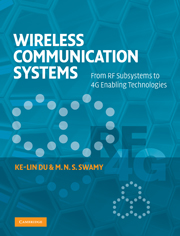Book contents
- Frontmatter
- Contents
- Preface
- Abbreviations
- 1 Introduction
- 2 An overview of wireless communications
- 3 Channel and propagation
- 4 Cellular and multiple-user systems
- 5 Diversity
- 6 Channel estimation and equalization
- 7 Modulation and detection
- 8 Spread spectrum communications
- 9 Orthogonal frequency division multiplexing
- 10 Antennas
- 11 RF and microwave subsystems
- 12 A/D and D/A conversions
- 13 Signals and signal processing
- 14 Fundamentals of information theory
- 15 Channel coding
- 16 Source coding I: speech and audio coding
- 17 Source coding II: image and video coding
- 18 Multiple antennas: smart antenna systems
- 19 Multiple antennas: MIMO systems
- 20 Ultra wideband communications
- 21 Cognitive radios
- 22 Wireless ad hoc and sensor networks
- Appendix A The Q-function
- Appendix B Wirtinger calculus
- Index
2 - An overview of wireless communications
Published online by Cambridge University Press: 05 June 2012
- Frontmatter
- Contents
- Preface
- Abbreviations
- 1 Introduction
- 2 An overview of wireless communications
- 3 Channel and propagation
- 4 Cellular and multiple-user systems
- 5 Diversity
- 6 Channel estimation and equalization
- 7 Modulation and detection
- 8 Spread spectrum communications
- 9 Orthogonal frequency division multiplexing
- 10 Antennas
- 11 RF and microwave subsystems
- 12 A/D and D/A conversions
- 13 Signals and signal processing
- 14 Fundamentals of information theory
- 15 Channel coding
- 16 Source coding I: speech and audio coding
- 17 Source coding II: image and video coding
- 18 Multiple antennas: smart antenna systems
- 19 Multiple antennas: MIMO systems
- 20 Ultra wideband communications
- 21 Cognitive radios
- 22 Wireless ad hoc and sensor networks
- Appendix A The Q-function
- Appendix B Wirtinger calculus
- Index
Summary
Roadmap of cellular communications
First-generation systems
The 1G mobile cellular systems were analog speech communication systems. They were mainly deployed before 1990. They are featured by FDMA (frequency division multiple access) coupled with FDD (frequency division duplexing), analog FM (frequency modulation) for speech modulation, and FSK (frequency shift keying) for control signaling, and provide analog voice services. The 1G systems were mainly deployed at the frequency bands from 450 MHz to 1 GHz. The cell radius is between 2 km and 40 km.
The AMPS (Advanced Mobile Phone Services) technique was developed by Bell Labs in the 1970s and was first deployed in late 1983. Each channel occupies 30 kHz. The speech modulation is FM with a frequency deviation of ±12 kHz, and the control signal is modulated by FSK with a frequency deviation of ±8 kHz. The control channel transmits the data streams at 10 kbits/s. AMPS was deployed in the USA, South America, Australia, and China. In 1991, Motorola introduced the N-AMPS to support three users in a 30 kHz AMPS channel, each with a 10 kHz channel, thus increasing the capacity threefold.
The European TACS (Total Access Communication System) was first deployed in 1985. TACS is identical to AMPS, except for the channel bandwidth of 25 kHz. Speech is modulated by FM with a frequency deviation of ±12 kHz, and the control signal is modulated by FSK with a frequency deviation of ±6.4 kHz, achieving a data rate of 8 kbits/s.
- Type
- Chapter
- Information
- Wireless Communication SystemsFrom RF Subsystems to 4G Enabling Technologies, pp. 11 - 38Publisher: Cambridge University PressPrint publication year: 2010



